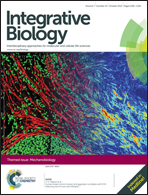Traction stress analysis and modeling reveal that amoeboid migration in confined spaces is accompanied by expansive forces and requires the structural integrity of the membrane–cortex interactions†
Abstract
Leukocytes and tumor cells migrate via rapid shape changes in an amoeboid-like manner, distinct from mesenchymal cells such as fibroblasts. However, the mechanisms of how rapid shape changes are caused and how they lead to migration in the amoeboid mode are still unclear. In this study, we confined differentiated human promyelocytic leukemia cells between opposing surfaces of two pieces of polyacrylamide gels and characterized the mechanics of fibronectin-dependent mesenchymal versus fibronectin-independent amoeboid migration. On fibronectin-coated gels, the cells form lamellipodia and migrate mesenchymally. Whereas in the absence of cell–substrate adhesions through fibronectin, the same cells migrate by producing blebs and “chimneying” between the gel sheets. To identify the orientation and to quantify the magnitude of the traction forces, we found by traction force microscopy that expanding blebs push into the gels and generate anchoring stresses whose magnitude increases with decreasing gap size while the resulting migration speed is highest at an intermediate gap size. To understand why there exists such an optimal gap size for migration, we developed a computational model and showed that the chimneying speed depends on both the magnitude of intracellular pressure as well as the distribution of blebs around the cell periphery. The model also predicts that the optimal gap size increases with weakening cell membrane to actin cortex adhesion strength. We verified this prediction experimentally, by weakening the membrane–cortex adhesion strength using the ezrin inhibitor, baicalein. Thus, the chimneying mode of amoeboid migration requires a balance between intracellular pressure and membrane–cortex adhesion strength.

- This article is part of the themed collection: Mechanobiology

 Please wait while we load your content...
Please wait while we load your content...